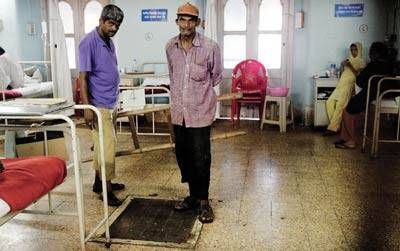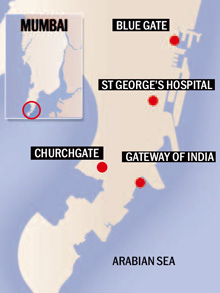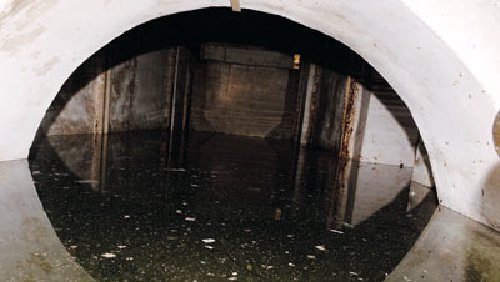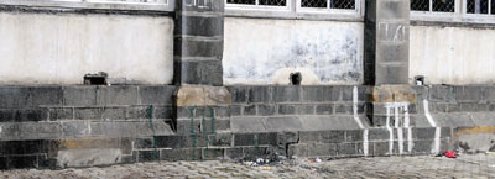Mumbai Vaults/tunnels/bunker after Indian revolt 1857-made by scared British=CST;governors bungalow;post office.ward no5 st george hospital ...
Cash vault at CST to be thrown open to public
The Central Railway will expand the heritage gallery at CST and make the vault a part of it.
The veil of mystery over a British underground cash vault at Chhatrapati Shivaji Terminus is likely to be lifted soon, and heritage lovers will be able to access the strong room that used to stash away all the daily collections a century ago.
The Central Railway has decided to not only make the secret cash vault at CST a part of the heritage museum, but throw it open to the public.
“We are going to expand the heritage gallery of CST and the cash vault will also be part of this gallery in future,” DK Sharma, General Manager, Central Railway told Mumbai Mirror on Friday.
Asked when heritage lovers can access the vault, Sharma said the process of expanding the heritage gallery is ongoing, and within a year the entire project would be completed.
The Central Railway has decided to shift the cash office for the expansion of the heritage gallery.
The cash vault is tucked away in a corridor that houses the heritage gallery and is hardly noticed in the hustle bustle of CST station.
According to officials, the cash vault began to be used for storing cash and key documents under tight security somewhere before 1890, and the system continued for nearly 100 years. Daily cash collections from Central Railway’s reservation counters and stations were transported here before being despatched to the bank the following day.
The vault has over 44 strongboxes and these coffers were moved into the basement through a pulley-driven lift, which were pulled by two employees. Around 15 years ago, the Central Railway stopped the practice of collecting cash in the vault overnight, and started sending the daily collection straight to the bank.

.........................................................................................................................

 Maharashtra Governor Ch Vidyasagar Rao inspecting the tunnel along with
Chief Minister Devendra Fadnavis at Raj Bhavan. (Source:
Twitter/Devendra Fadnavis)Maharashtra
Governor Ch Vidyasagar Rao has discovered a 150-metre long underground
British era bunker inside the Raj Bhavan complex at Malabar Hill. Officials
from Raj Bhavan said the bunker had been closed for several decades.
The Governor, who visited the bunker along with his wife and Chief
Minister Devendra Fadnavis Tuesday, has decided to consult experts from various fields regarding its preservation.
Maharashtra Governor Ch Vidyasagar Rao inspecting the tunnel along with
Chief Minister Devendra Fadnavis at Raj Bhavan. (Source:
Twitter/Devendra Fadnavis)Maharashtra
Governor Ch Vidyasagar Rao has discovered a 150-metre long underground
British era bunker inside the Raj Bhavan complex at Malabar Hill. Officials
from Raj Bhavan said the bunker had been closed for several decades.
The Governor, who visited the bunker along with his wife and Chief
Minister Devendra Fadnavis Tuesday, has decided to consult experts from various fields regarding its preservation.
The bunker, spread over an area of more than 5,000 sqft, has rooms bearing the names Shell Store, Gun Shell, Cartridge Store, Shell Lift, Pump, Workshop, etc. There are also scores of lamp recesses in the gangway of the bunker, said an official.
“About three months ago, when the Governor was informed by old timers that a tunnel exists inside Raj Bhavan, the Governor asked to have it opened,” said an official.

Public Works Department staff were surprised after they broke open a temporary wall that closed the entrance to the bunker on the eastern side. “Instead of an underground tunnel, an entire barrack with 13 rooms of different sizes was found. The bunker opens with a 20-ft tall gate and a ramp on the western side. There are long passages and small-to-medium rooms on either side,” explained the official.
“Even though the bunker was apparently closed after Independence, it was found to be surprisingly intact. Interestingly, the entire underground bunker has a drainage system and inlets for fresh air and light,” added the official.
Chief Minister Devendra Fadnavis visited the Bunker late in the evening Tuesday. He later tweeted pictures of his visit and described the tunnel as an “amazing discovery” by the governor.

Raj Bhavan, formerly known as ‘Government House’, served as the residence of British Governors since 1885 when Lord Reay turned it into a permanent residence. Prior to 1885, the Malabar Hill residence served as the Summer Residence of the British Governors and the Government House at Parel served as the Governor’s residence before 1885.

Historians say such bunkers are well known in military history. “It is good that the present Governor is taking interest in history. Such bunkers used to be an escape routes for the then Britishers to hide in an emergency. Also, a tunnel has been found below the government post office in Fort. So, it was common in those era,” said Deepak Rao, a historian.
.....................................................................................................................
.................................................................................................................

The tunnel has tiny skylights that also let some fresh air in, not enough though. The tunnel smells of rotten flesh, enough to make anybody sick in a matter of minutes.
Former superintendent of St George’s Hospital, Dr K N Varade, said he got the tunnel door opened once during his tenure.
“The wooden plank covering the tunnel’s opening was damaged. I got it fixed. We did not talk about the tunnel because we didn’t want the Archaeological Survey of India to step in and take over this part of the hospital,” he said.
 Line 3 of the Mumbai Metro, also referred to as the Colaba–Bandra-SEEPZ line, is a part of the metro system for the city of Mumbai, India of which construction has been initiated. When completed, the 33.5-km long line will be the first underground metro line in Mumbai.
Line 3 of the Mumbai Metro, also referred to as the Colaba–Bandra-SEEPZ line, is a part of the metro system for the city of Mumbai, India of which construction has been initiated. When completed, the 33.5-km long line will be the first underground metro line in Mumbai.
The veil of mystery over a British underground cash vault at Chhatrapati Shivaji Terminus is likely to be lifted soon, and heritage lovers will be able to access the strong room that used to stash away all the daily collections a century ago.
The Central Railway has decided to not only make the secret cash vault at CST a part of the heritage museum, but throw it open to the public.
“We are going to expand the heritage gallery of CST and the cash vault will also be part of this gallery in future,” DK Sharma, General Manager, Central Railway told Mumbai Mirror on Friday.
Asked when heritage lovers can access the vault, Sharma said the process of expanding the heritage gallery is ongoing, and within a year the entire project would be completed.
The Central Railway has decided to shift the cash office for the expansion of the heritage gallery.
The cash vault is tucked away in a corridor that houses the heritage gallery and is hardly noticed in the hustle bustle of CST station.
According to officials, the cash vault began to be used for storing cash and key documents under tight security somewhere before 1890, and the system continued for nearly 100 years. Daily cash collections from Central Railway’s reservation counters and stations were transported here before being despatched to the bank the following day.
The vault has over 44 strongboxes and these coffers were moved into the basement through a pulley-driven lift, which were pulled by two employees. Around 15 years ago, the Central Railway stopped the practice of collecting cash in the vault overnight, and started sending the daily collection straight to the bank.
.........................................................................................................................
- Maharashtra Governor Ch Vidyasagar Rao has discovered a 150-metre long underground British era bunker inside the Raj Bhavan complex at Malabar Hill.
- gulfnews.com
- › News
- › Asia
- › India
Mumbai: A 150-metre long underground British era bunker has been discovered under Raj Bhavan, the official residence of the Governor of Maharshtra. About three months .
Maharashtra Governor Ch Vidyasagar Rao finds underground bunker from British era inside Raj Bhavan
The Governor, who visited the bunker along with his wife and Chief Minister Devendra Fadnavis Tuesday, has decided to consult experts from various fields regarding its preservation.
By: Express News Service | Mumbai |
Updated: August 17, 2016 2:08 am

The bunker, spread over an area of more than 5,000 sqft, has rooms bearing the names Shell Store, Gun Shell, Cartridge Store, Shell Lift, Pump, Workshop, etc. There are also scores of lamp recesses in the gangway of the bunker, said an official.
“About three months ago, when the Governor was informed by old timers that a tunnel exists inside Raj Bhavan, the Governor asked to have it opened,” said an official.
Public Works Department staff were surprised after they broke open a temporary wall that closed the entrance to the bunker on the eastern side. “Instead of an underground tunnel, an entire barrack with 13 rooms of different sizes was found. The bunker opens with a 20-ft tall gate and a ramp on the western side. There are long passages and small-to-medium rooms on either side,” explained the official.
“Even though the bunker was apparently closed after Independence, it was found to be surprisingly intact. Interestingly, the entire underground bunker has a drainage system and inlets for fresh air and light,” added the official.
Chief Minister Devendra Fadnavis visited the Bunker late in the evening Tuesday. He later tweeted pictures of his visit and described the tunnel as an “amazing discovery” by the governor.
Raj Bhavan, formerly known as ‘Government House’, served as the residence of British Governors since 1885 when Lord Reay turned it into a permanent residence. Prior to 1885, the Malabar Hill residence served as the Summer Residence of the British Governors and the Government House at Parel served as the Governor’s residence before 1885.
Historians say such bunkers are well known in military history. “It is good that the present Governor is taking interest in history. Such bunkers used to be an escape routes for the then Britishers to hide in an emergency. Also, a tunnel has been found below the government post office in Fort. So, it was common in those era,” said Deepak Rao, a historian.
.....................................................................................................................
- 200-year-old tunnel found in Mumbai ... Mumbai: An ancient tunnel dating back 200 years was discovered on the premises of the General Post Office (GPO) at CST in ...Mumbai: An ancient tunnel dating back 200 years was discovered on the premises of the General Post Office (GPO) at CST in Mumbai on Monday.
MiD DAY learnt about this slice of history and informed the GPO authorities three days ago. Initially, the authorities refused to believe that they could be sitting, in more ways than one, on such an ancient passageway. Soon, it was thrill and excitement at the discovery and then a resolve to dig deeper and find out more about this passage.
Chief Postmaster General (Maharashtra & Goa) Faiz ur Rehman was not amused when he was first told about the tunnel.
"In the last 25 years that I've been working at this building, I've never heard about any such thing," said Rehman. "We'd like to confirm any such existence before making any comments to the media."
Yesterday, Rehman, who was in Aurangabad, was astounded when told about the passageway.
"It's like a treasure for the GPO. We are thankful to MiD DAY for bringing this fact to our notice and want to explore it as much as we can to understand what it could have been for ages together," said Rehman.
"We will seek assistance from the heritage department and others concerned to unearth this mystery."
With other senior officials at the GPO, it was a similar tale of disbelief turning into surprise.
"Neither have I ever heard of any such a passageway," said Postal Director Abha Singh who later said she admitted that the entire area surrounding the GPO may be steeped in history.
"Truly, it's a treasure and we'd love to preserve it," said Singh.
She hoped that the passage could someday be converted into a museum and thrown open to the public.
Director of GPO Shobha Madhale, however, admitted to MiD DAY of having learnt of such a thing but could not explore it due to non-availability of resources.
Acting on a tip-off by this correspondent, Postal Director Abha Singh and a few employees
started making enquiries with liftman S S Jadhav who has been employed with the department for 26 years.
Jadhav confirmed having learnt of such an underground opening.
Along with Jadhav and a few other employees, MiD DAY went to a garden in front of the building. There, we came across a cement structure covered with a lid and a flowerpot placed on it. It took at least three people to open the lid.
Inside was a rusted iron ladder, leading to a muddy floor. None of the people around mustered courage to step in. There were two other openings leading below each within a few metres of the other.
Postal Director Abha Singh gets the employees to open the lid in a garden in front of the GPO building.
A BMC drainage cleaning employee, who was at the spot, confirmed to MiD DAY that it could not be a drainage tank, as there was no foul stench of gas being emitted from the opening.
"I know each and every underground passage in front of the GPO but I've never come across anything like this before," he said.
He bolstered his claims by citing characteristics of tanks put by the civic body and confirmed that this one at GPO was not one of them.
"I cannot step in without using safety gear. Also, I need to inform my superiors before sending somebody inside," said the BMC employee.
Finally, postal employee Devji Waghela dared to enter, armed with an emergency lamp. "The mouth of the tunnel is wide open and any person can walk inside," said Waghela.
"Neither did I feel suffocated nor was the place stinking. I could see mud all over the place."
Waghela said he flashed the lamp he had and he could see a walkway-like passage flanked by strong walls as far as the eye reached.
Chairman of Mumbai Heritage Committee, Dinesh Afzalpurkar, said he would ask his officials to visit the site and study if the place has any historical background.
"We will certainly examine if it [the discovery] has any heritage value and needs to be persevered. We will write to the state government to declare it a heritage structure," said Afzalpurkar.
Assistant Director of the state Archaeological Department, Balchandra Kulkarni, said, "It would truly be a great contribution by MiD DAY if this leads to a forgotten treasure from the British era."
Kulkarni said the tunnel could either be a drainage line used during the British era or an escape route.
"Things will be clear only after a detailed study. Whatever, it's interesting and I will want to conduct a personal study of the findings," he said.
Kulkarni, who has studied Mumbai's forts said the British feared an attack by Napoleon and had constructed an underground escape route stretching from Apollo Bunder to where the Bombay High Court stands and St George's Fort (covering St George Hospital to Masjid Bunder).
A 1.5-km tunnel also exists in the adjacent St George Hospital's ward number 5.
"I have studied the St George fort passageway which opens inside St George Hospital but that passage connects to a dead end and nothing concrete could be concluded from there," said Kulkarni.
Reporter narrates how he cracked the story;
During the course of my visits to the GPO a senior postal official had, during a casual chat, told me about a tehkhana (dungeon) beneath the GPO. I had then made a mental note to explore this nugget of information. I even discussed about this with the former Chief Postmaster General and other senior officials, including Director (GPO) Shobha Madhale, but nothing transpired.
Somehow, this tehkhana played on my mind every time I stepped into the GPO building.Last Friday, I mentioned it to Postal Director Abha Singh and she ushered me into the office of the Chief Postmaster General Faiz ur Rehman who summoned staffers and asked them to enquire.
Postal Assistant Director S B Vyavahare entered the office with lift operator Jadhav who corroborated my statement. Rehman then promised an internal investigation and said he would revert on Monday, which he did.
History check
The British who were ruling Bombay during the 18th century feared that Napoleon would attack Bombay. In order to protect themselves, they constructed an underground escape passage route called Bombay Fort. However, Napolean was defeated in the Battle of Waterloo in 1815.
1862
Year the Bombay Fort was demolished by the British
1913
Year the GPO building was erected. - 200-year-old tunnel unearthed in Mumbai's GPO. Shares 0; Wed, 20 Oct 2010-09:05pm , ... A 200-year-old tunnel was unearthed by workers of the General Post Office ...
- Oct 22, 2010 · Mumbai post office yields mysterious tunnel-20 October 2010 An ancient "tunnel-like" structure has been unearthed in the garden of the General Post Office ...
- Oct 19, 2010 · ... tunnel-like structure is discovered in the garden of the General Post Office in the Indian city of Mumbai. ... Mumbai post office yields mysterious tunnel.
Tunnel below GPO is a 100-yr-old water harvesting system
Posted On Thursday, June 14, 2012 at 11:31:56 AM
Team from ASI and Pune institute discovers that ducts below the heritage monument lead to a reservoir; GPO plans to revive it
A
water duct at the General Post Office (GPO) building, thought until now
to be a storm water disposal unit, is actually a rain water harvesting
unit. And the system, if the GPO has it way, will be restored to it
original function by next year.
The ducts at the nearly century-old structure were discovered below the garden in 2010. However, their true function was discovered post a joint study by the Archaeological Survey of India (ASI) and Pune’s Deccan College Post Graduate and Research Institute, which is the largest institute on heritage archaelogy in Asia.
The team from ASI - Nilesh Jadhav and Mayur Thakare - worked along with Vasant Shinde, the joint director of the Pune institute. The discovery was made on Wednesday and the team will file a detailed report soon.
Speaking about GPO’s rain-water harvesting system Shinde said, “There is one reservoir with four ducts. Its dimensions are 50x50m and the depth is about 7 feet. There is a 5ft accumulation of silt in the structure which made me deduce that it had earlier been used as a rain water harvesting unit.”
Shinde added that a similar rain-water harvesting unit, which was over 3,500 years old, was discovered at Inamgaon in Pune district, close to Shirur.
The team said that the Britishers constructed such rain-water harvesting units not only to make maximum use of rain but also to prevent flooding in low-lying areas.
During the monsoon, Shinde added, when the reservoir fills up, excess water gets filtered out through outlets located on the walls. The structure is made of stone fitted in grooves to avoid any leakage, making it environment-friendly.
Director of Postal Services, (HQ) Abha Singh said, “We have asked for an estimate of the cost needed to revive the unit. We have to send it to our Delhi office for approval. We hope that the inauguration of the revived model will coincide with our centenary celebration next year. We also plan to release a commemorative stamp of GPO along with this revived model depending on approvals.”
Shinde added that he believes that such water harvesting units exist underneath all the heritage structures in the vicinity, including the Chhatrapati Shivaji Terminus (CST)
The PRO of Central Railways A K Singh said the Railways would be very interested in exploring the possibility. “Currently we use 19 lakh litres of potable water daily, of which one lakh is recycled and used to clean compartments and rakes. Such a harvesting method, if successfully adopted, could benefit us greatly.”
The ducts at the nearly century-old structure were discovered below the garden in 2010. However, their true function was discovered post a joint study by the Archaeological Survey of India (ASI) and Pune’s Deccan College Post Graduate and Research Institute, which is the largest institute on heritage archaelogy in Asia.
The team from ASI - Nilesh Jadhav and Mayur Thakare - worked along with Vasant Shinde, the joint director of the Pune institute. The discovery was made on Wednesday and the team will file a detailed report soon.
Speaking about GPO’s rain-water harvesting system Shinde said, “There is one reservoir with four ducts. Its dimensions are 50x50m and the depth is about 7 feet. There is a 5ft accumulation of silt in the structure which made me deduce that it had earlier been used as a rain water harvesting unit.”
Shinde added that a similar rain-water harvesting unit, which was over 3,500 years old, was discovered at Inamgaon in Pune district, close to Shirur.
The team said that the Britishers constructed such rain-water harvesting units not only to make maximum use of rain but also to prevent flooding in low-lying areas.
During the monsoon, Shinde added, when the reservoir fills up, excess water gets filtered out through outlets located on the walls. The structure is made of stone fitted in grooves to avoid any leakage, making it environment-friendly.
Director of Postal Services, (HQ) Abha Singh said, “We have asked for an estimate of the cost needed to revive the unit. We have to send it to our Delhi office for approval. We hope that the inauguration of the revived model will coincide with our centenary celebration next year. We also plan to release a commemorative stamp of GPO along with this revived model depending on approvals.”
Shinde added that he believes that such water harvesting units exist underneath all the heritage structures in the vicinity, including the Chhatrapati Shivaji Terminus (CST)
The PRO of Central Railways A K Singh said the Railways would be very interested in exploring the possibility. “Currently we use 19 lakh litres of potable water daily, of which one lakh is recycled and used to clean compartments and rakes. Such a harvesting method, if successfully adopted, could benefit us greatly.”
.................................................................................................................
Mirror reporters discovery of 18th century tunnel from St George’s Hospital that has exits at Gateway, Churchgate and Blue Gate
Mirror reporters discover 18th century tunnel from St George’s Hospital that has exits at Gateway, Churchgate and Blue Gate
This is possibly
Mumbai’s best-kept secret and most certainly the shortest shortcut to
reach the Gateway, Churchgate or the Blue Gate from St George’s Hospital
on P D’mello Road.
Two Mumbai Mirror reporters on Thursday discovered an over 240-year-old tunnel tucked under the St George’s Hospital.
The 1.5 km tunnel, now full of muck and
sea water, starts under Ward 5 of the hospital and has exits at the
Gateway, the Blue Gate and Churchgate.
|
PWD workers stand next to the trap door leading to Underground Rain Water Harvesting System at St George’s Hospital at ward no 5
|
With its lone entrance, covered by a
wooden hatch now, plonked right in the middle of the Swine Flu ward, the
tunnel for many years has been a source of great curiosity and many
unfounded stories in the hospital.
The wooden hatch was raised and a ladder
lowered into the tunnel to let the two reporters explore its depths. But
they found that they could not go beyond a few metres.
The tunnel’s three arms lay blocked with
brick-and-mud walls. There was knee deep water in the tunnel and
hospital staff said the level would rise as monsoon progresses.
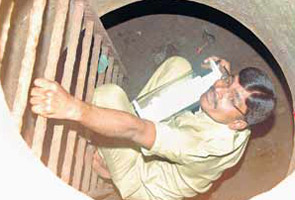 |
|
Getting down the 1.5 Km Long tunnel at the Hospital
|
Historians say since the Dutch, the
French and the Portuguese posed a constant threat, the Britishers built a
network of tunnels starting from St George’s Fort, present day’s St
George’s Hospital.
Urban historian Sharada Dwivedi said she
had come across the St George’s Hospital tunnel during her research on
Mumbai’s past. “There are many tunnels from the British period which run
through the Fort area.
The St George’s hospital tunnel may be connected to Apollo Bunder (Gateway of India),
Churchgate and Blue Gate. These secret passageways tell us a lot about
our past and they need to be protected and preserved,” she said.The tunnel has tiny skylights that also let some fresh air in, not enough though. The tunnel smells of rotten flesh, enough to make anybody sick in a matter of minutes.
Former superintendent of St George’s Hospital, Dr K N Varade, said he got the tunnel door opened once during his tenure.
“The wooden plank covering the tunnel’s opening was damaged. I got it fixed. We did not talk about the tunnel because we didn’t want the Archaeological Survey of India to step in and take over this part of the hospital,” he said.
THE TUNNEL SHOULD BE PROPERLY MAPPED OUT TO PREVENT:_
[1] FUTURE CAVE INS
[2]DANGER TO BUILDINGS OLD AND NEW AND ITS PILINGS
[3] TO USE AS RAINWATER HARVESTING MEANS
[4] TO PREVENT IT BEING USED BY DRUG ADDICTS, CRIMINALS, TERRORIST & NAXALS ETC,
[5] CARRYING OUT CLEANING AND MAINTAINING THE TUNNELS IF RAINWATER HARVESTING IS USED.
[6] USING IT AS RAINWATER HARVESTING TANK COULD PREVENT FLOODING DURING HIGHTIDE.

Line 3 (Mumbai Metro) [danger to metro?]
- Wikipedia
https://en.wikipedia.org/wiki/Line_3_(Mumbai_Metro)
Line length: 33.05 km (20.54 mi)
Planned opening: 2020
Stations: 27
Status: Under construction
| Line 3 | ||||
|---|---|---|---|---|
| # | Station Name[129] | Connections | ||
| 1 | Cuffe Parade | None | ||
| 2 | Vidhan Bhavan | None | ||
| 3 | Churchgate | Western Line | ||
| 4 | Hutatma Chowk | None | ||
| 5 | CST Metro | Central Line | ||
| 6 | Kalbadevi | None | ||
| 7 | Girgaon | None | ||
| 8 | Grant Road | Western Line | ||
| 9 | Mumbai Central Metro | Western Line | ||
| 10 | Mahalaxmi | Western Line Monorail |
||
| 11 | Science Museum | None | ||
| 12 | Acharya Atrey Chowk | None | ||
| 13 | Worli | None | ||
| 14 | Siddhivinayak | None | ||
| 15 | Dadar | Western Line Central Line |
||
| 16 | Sitaladevi | None | ||
| 17 | Dharavi | None | ||
| 18 | BKC | Line 2 (Planned) | ||
| 19 | Vidyanagri | None | ||
| 20 | Santacruz | None | ||
| 21 | Domestic Airport | Line 7 (Planned) | ||
| 22 | Sahar Road | Line 7 (Planned) | ||
| 23 | International Airport | Line 7 (Planned) | ||
| 24 | Marol Naka | Line 1 | ||
| 25 | MIDC | None | ||
| 26 | SEEPZ | None | ||
| 27 | Aarey Depot | None | ||
